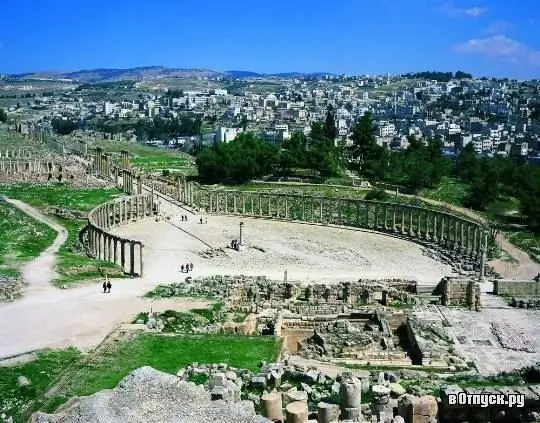
Description of the attraction
The ancient city of Jerash is practically the second most popular city in Jordan after Petra. People have been living in this place continuously for 6500 years.
Jerash is located in a valley surrounded by wooded hills and fertile valleys. Conquered by General Pompey in 63 BC BC, Jerash passed to the Romans and was included in the Decapolis (Decapolis).
The city's golden age fell on the era of Roman rule - then it was known as Gerasa. Today Jerash is recognized as one of the best preserved provincial Roman cities in the world. For centuries, the city has been hidden under tons of sand - excavations only began 70 years ago. Jerash is an excellent example of provincial Roman town planning, examples of which can be found throughout the Middle East. This style is characterized by cobbled streets with colonnades, majestic temples on the hills, magnificent amphitheatres, spacious city squares, baths, fountains, as well as massive city walls with towers and gates.
Under this Greco-Roman shell, Jerash houses an exquisite blend of Eastern and Western cultures. In its architecture, religion and languages, there are traces of the collision and interpenetration of two leading cultures - the Greco-Roman culture of the Mediterranean and the traditions of the Arab East.
Description added:
Russian speaking guide in Jordan 2015-13-12
The ancient city of Jerash is practically the second most popular city in Jordan after Petra. People have been living in this place continuously for 6500 years. Jerash is located in a valley surrounded by wooded hills and fertile valleys. Conquered by General Pompey in 63 BC B. C., Jerash passed
Show full text The ancient city of Jerash is practically the second most popular city in Jordan after Petra. People have been living in this place continuously for 6500 years. Jerash is located in a valley surrounded by wooded hills and fertile valleys. Conquered by General Pompey in 63 BC BC, Jerash passed to the Romans and was included in the Decapolis (Decapolis).
The city's golden age fell on the era of Roman rule - then it was known as Gerasa. Today Jerash is recognized as one of the best preserved provincial Roman cities in the world. For centuries, the city has been hidden under tons of sand - excavations only began 70 years ago.
Jerash is an excellent example of provincial Roman town planning, examples of which can be found throughout the Middle East. This style is characterized by cobbled streets with colonnades, majestic temples on the hills, magnificent amphitheaters, spacious city squares, baths, fountains, as well as massive city walls with towers and gates. Under this Greco-Roman shell, Jerash houses an exquisite blend of Eastern and Western cultures. In its architecture, religion and languages, there are traces of the collision and interpenetration of two great cultures - the Greco-Roman culture of the Mediterranean and the traditions of the Arab East. Practical clothing and comfortable, reliable footwear are best for walking through the ruins. During the summer months, remember to wear a hat and sunglasses, and bring a supply of drinking water. Modern Jerash is located east of the ancient ruins. The new city begins right behind the wall of the old one, but, despite this, the historical monuments remain intact thanks to a well-thought-out urban planning policy.
Natural beauty and gorgeous Arab medieval military architecture have given northern Jordan two of the most significant ecological and historical landmarks in the entire Middle East. These are the vast pine forests of Ajlun-Dibbin and the Ayyubid castle towering over the village of Ajlun, with the help of which the crusaders were defeated eight centuries ago. Ajlun Castle (Kal'at al-Rabad), located on the top of the mountain, was built in 1184 by one of Saladin's generals to guard the iron mines and protect Ajlun from the attacks of the Franks.
Ajloun Castle towered over the three main routes to the Jordan Valley and protected the trade routes between Jordan and Syria. It was an important link in a chain of defenses designed to defend against the Crusaders, who for decades tried unsuccessfully to capture the castle and the neighboring village. Initially, the castle had four towers with loopholes in thick walls and loopholes for archers and was surrounded by a moat 16 meters wide and 15 meters deep. In 1215, the Mamluk governor, Aybak ibn Abdullah, expanded the castle by adding another tower on the southeast corner and erecting a bridge decorated with dove figurines, which can still be seen today. In the XII century. the castle was surrendered to the ruler of Aleppo and Damascus, Salah ad-Din Yusuf ibn Ayyub. Under him, the north-east tower was restored. In 1260, work on the reconstruction of the castle was interrupted, and it fell under the onslaught of the Mongols. Soon, however, the Mamluk Sultan Baybars conquered the fortress and rebuilt it.
If you have binoculars, take them with you to Jordan. With its help, you can not only observe wild animals in the reserves, but also enjoy the fantastic views that open, for example, from Ajlun Castle. Ajlun can be quickly reached from Jerash by a road through pine forests and olive groves. On site, you will see many ancient monuments: watermills, fortresses, settlements, and all this - against the backdrop of the beautiful hills and valleys of northern Jordan.
Nearby is the stunning beauty of the Ajlun reserve - 13 square kilometers of diversity of flora and fauna. There are two tourist routes in the reserve. You can stay right on site in the cabins The reserve is administered by the Royal Society for the Conservation of Nature (RSCN).
Hide text






